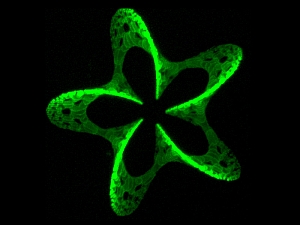Researchers in materials science and chemistry at Vienna University of Technology in Austria devised a method to place living molecules to grow tissue in precise locations on three-dimensional surfaces. The teams led by Vienna materials scientist Jürgen Stampfl and macromolecular chemist Robert Liska published their findings last week in the journal Advanced Functional Materials (paid subscription required).
The process developed by Stampfl and Liska, called 3-D photografting, starts with a hydrogel, a network of macromolecules configured in a loose matrix or mesh with pores large enough for other molecules or cells to fit. The researchers introduced molecules from special compounds into the mesh, then irradiated certain points with lasers.
Where the beams were most intense, the lasers could break photochemical bonds, making it possible to create highly reactive intermediate compounds that attached quickly to the hydrogel mesh. The lasers could focus their most intense beams in precise locations, with that precision limited only by the capabilities of the laser; the Vienna team achieved a resolution of 4 micrometers (1 micrometer equals 1 millionth of a meter).
“Much like an artist, placing colors at certain points of the canvas,” says lead author and materials scientist Aleksandr Ovsianikov, “we can place molecules in the hydrogel, but in three dimensions and with high precision.” The researchers produced a 3-D star-shaped pattern using fluorescent molecules attached to the hydrogel mesh (pictured at top).
The Vienna researchers say this hydrogel mesh can provide a form of scaffolding on which engineered tissue can be created. In natural tissue, specific amino acid sequences send signals to the cells, instructing them where to grow. Other potential applications are microscopic sensors and 3-D lab-on-a-chip diagnostic devices.
Read more:
- Composite Nanofibers Developed for Orthopedic Biomaterials
- U.S. Patent Issued for Stem Cell Wound Care Technology
- Natural Lightweight Material Exhibits Strength, Toughness
- Universities License Regenerative Membrane Technology
* * *


 RSS - Posts
RSS - Posts
[…] Lasers Employed to Created Precise Molecular Designs […]